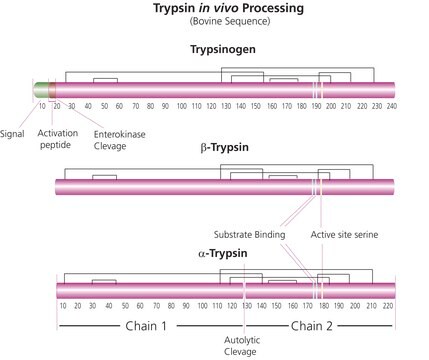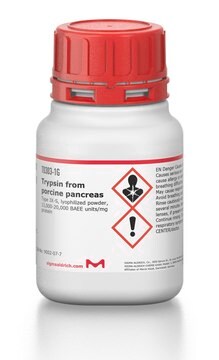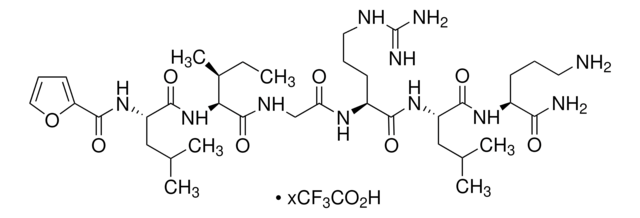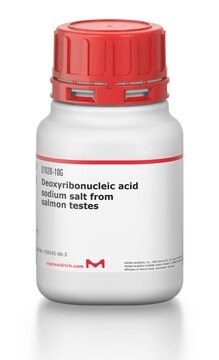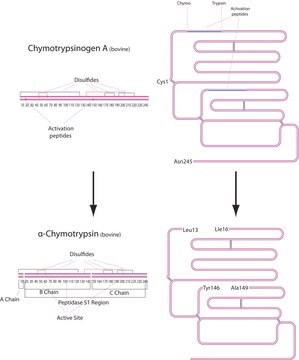T9201
Trypsin from bovine pancreas
powder, ≥7,500 BAEE units/mg solid
Synonym(s):
Serine Protease 1
Sign Into View Organizational & Contract Pricing
All Photos(6)
About This Item
Recommended Products
form
powder
Quality Level
specific activity
≥7,500 BAEE units/mg solid
mol wt
23.8 kDa
composition
, ≥90 % protein
impurities
≤3 BTEE units/mg solid Chymotrypsin
storage temp.
−20°C
Looking for similar products? Visit Product Comparison Guide
Related Categories
Application
For trypsin digestion of peptides, use a ratio of about 1:100 to 1:20 for trypsin:peptide. The typical use for this product is in removing adherent cells from a culture surface. The concentration of trypsin necessary to dislodge cells from their substrate is dependent primarily on the cell type and the age of the culture. Trypsins have also been used for the re-suspension of cells during cell culture, in proteomics research for digestion of proteins and in various in-gel digestions. Additional applications include assessing crystallization by membrane-based techniques and in a study to determine that protein folding rates and yields can be limited by the presence of kinetic traps.
Biochem/physiol Actions
Trypsin cleaves peptides on the C-terminal side of lysine and arginine residues. The rate of hydrolysis of this reaction is slowed if an acidic residue is on either side of the cleavage site and hydrolysis is stopped if a proline residue is on the carboxyl side of the cleavage site. The optimal pH for trypsin activity is 7-9. Trypsin can also act to cleave ester and amide linkages of synthetic derivatives of amino acids. EDTA is added to trypsin solutions as a chelating agent that neutralizes calcium and magnesium ions that obscure the peptide bonds on which trypsin acts. Removing these ions increases the enzymatic activity.
Serine protease inhibitors, including DFP, TLCK, APMSF, AEBSEF, and aprotinin, amongst others, will inhibit Trypsin.
Serine protease inhibitors, including DFP, TLCK, APMSF, AEBSEF, and aprotinin, amongst others, will inhibit Trypsin.
Components
Trypsin consists of a single chain polypeptide of 223 amino acid residues, produced by the removal of the N-terminal hexapeptide from trypsinogen which is cleaved at the Lys - lle peptide bond. The sequence of amino acids is cross-linked by 6 disulfide bridges. This is the native form of trypsin, beta-trypsin. BETA-trypsin can be autolyzed, cleaving at the Lys - Ser residue, to produce alpha-trypsin. Trypsin is a member of the serine protease family.
Caution
Solutions in 1 mM HCl are stable for 1 year in aliquots and stored at -20°C. The presence of Ca2+ will also diminish the self-autolysis of trypsin and maintain its stability in solution. Trypsin will also retain most of its activity in 2.0 M urea, 2.0 M guanidine HCl, or 0.1% (w/v) SDS.
Unit Definition
One BAEE unit will produce a A253 of 0.001 per minute at pH 7.6 at 25°C using BAEE as a substrate.
Preparation Note
This product is from pancreas sourced from New Zealand. It is soluble in 1 mM HCl at 1 mg/mL.
replaced by
Product No.
Description
Pricing
Signal Word
Danger
Hazard Statements
Precautionary Statements
Hazard Classifications
Eye Irrit. 2 - Resp. Sens. 1 - Skin Irrit. 2 - STOT SE 3
Target Organs
Respiratory system
Storage Class Code
11 - Combustible Solids
WGK
WGK 1
Personal Protective Equipment
dust mask type N95 (US), Eyeshields, Gloves
Choose from one of the most recent versions:
Already Own This Product?
Find documentation for the products that you have recently purchased in the Document Library.
Customers Also Viewed
Vandana Shashi et al.
Human mutation, 40(8), 1115-1126 (2019-07-03)
Encoding the slow skeletal muscle isoform of myosin binding protein-C, MYBPC1 is associated with autosomal dominant and recessive forms of arthrogryposis. The authors describe a novel association for MYBPC1 in four patients from three independent families with skeletal muscle weakness
Rasmus Karstad et al.
Journal of medicinal chemistry, 55(14), 6294-6305 (2012-06-23)
This study investigates how the S1 and S3 site of trypsin can be challenged with cationic amino acid analogues to yield active antimicrobial peptides with stability toward tryptic degradation. It is shown that unnatural analogues can be incorporated to generate
Claire E J Waterborg et al.
PloS one, 13(10), e0205902-e0205902 (2018-10-20)
Rheumatoid arthritis is an auto-immune disease of the synovial joints, hallmarked by chronic inflammation and subsequent progressive tissue destruction. TYRO3, AXL and MER (gene name Mertk) (TAM) receptors are part of a negative feedback signaling system in the immune reaction
Christo Nanev et al.
IUCrJ, 8(Pt 2), 270-280 (2021-03-13)
The nucleation ability of pores is explained using the equilibration between the cohesive energy maintaining the integrity of a crystalline cluster and the destructive energy tending to tear it up. It is shown that to get 3D crystals it is
Rachel Freire et al.
Scientific reports, 9(1), 7029-7029 (2019-05-09)
Celiac disease (CD) is an immune-mediated disorder triggered by gluten exposure. The contribution of the adaptive immune response to CD pathogenesis has been extensively studied, but the absence of valid experimental models has hampered our understanding of the early steps
Our team of scientists has experience in all areas of research including Life Science, Material Science, Chemical Synthesis, Chromatography, Analytical and many others.
Contact Technical Service